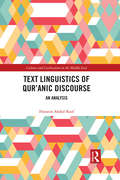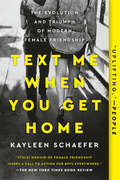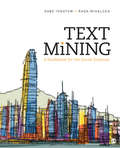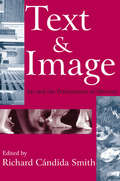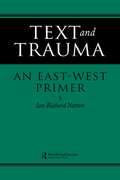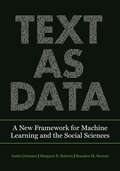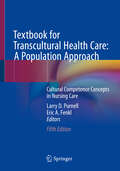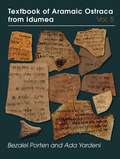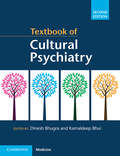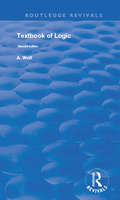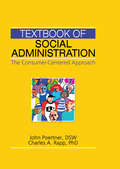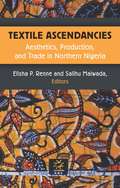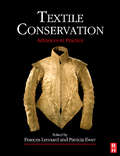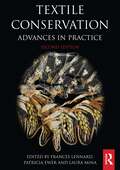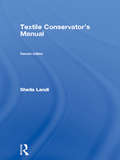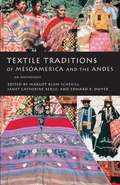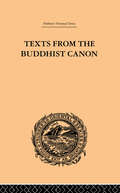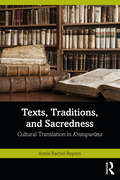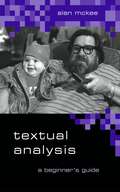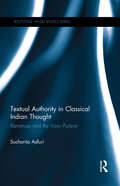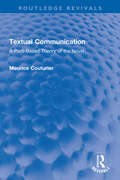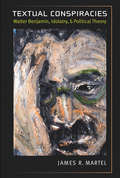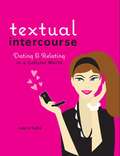- Table View
- List View
Text Linguistics of Qur'anic Discourse: An Analysis (Culture and Civilization in the Middle East)
by Hussein Abdul-RaofText Linguistics of Qur'anic Discourse is an in-depth investigation of the fabric of Qur'anic Discourse. It unravels the texture of the macro Qur'anic text; its cohesion and coherence systems; the notions of intertextuality, semantic relatedness, and thematic sequentiality; the macro textual features of ellipsis, repetition, and argumentation structure; and the contextual, co-textual, grammatical, and semantic factors involved in the macro Qur'anic text. This book is a valuable and methodologically consistent learning and teaching academic resource for universities worldwide in this intriguing new discipline. Through its methodologically coherent discussion and in-depth analysis that is hinged upon modern European text linguistics, Text Linguistics of Qur'anic Discourse provides an insight into the newly established discipline of text linguistics, and explores the different layers of the macro Qur'anic text as an academic requirement.
Text Me When You Get Home: The Evolution and Triumph of Modern Female Friendship
by Kayleen SchaeferA personal and sociological examination--and ultimately a celebration--of the evolution of female friendship in pop culture and modern society"Text me when you get home." After joyful nights out together, female friends say this to one another as a way of cementing their love. It's about safety; but more than that, it's about solidarity. From Broad City to Big Little Lies to what women say about their own best friends, the stories we're telling about female friendship have changed. What used to be written off as infighting between mean girls or disposable relationships that would be tossed as soon as a guy came along are no longer described like that. Now, we're lifting up our female friendships to the same level as our other important relationships, saying they matter just as much as the bonds we have with our romantic partners, children, parents, or siblings. Journalist Kayleen Schaefer relays her journey of modern female friendship: from being a competitive teenager to trying to be one of the guys in the workplace to ultimately awakening to the power of female friendship and the soulmates, girl squads, and chosen families that come with it. Schaefer has put together a completely new sociological perspective on the way we see our friends today, one that includes interviews with dozens of other women across the country: historians, creators of the most iconic films and television shows about female friendship (and Galentine's Day!), celebrities, authors, and other experts. The end result is a validation of female friendship that's never existed before.
Text Mining: A Guidebook for the Social Sciences
by Gabe Ignatow Rada F. MihalceaOnline communities generate massive volumes of natural language data and the social sciences continue to learn how to best make use of this new information and the technology available for analyzing it. Text Mining brings together a broad range of contemporary qualitative and quantitative methods to provide strategic and practical guidance on analyzing large text collections. This accessible book, written by a sociologist and a computer scientist, surveys the fast-changing landscape of data sources, programming languages, software packages, and methods of analysis available today. Suitable for novice and experienced researchers alike, the book will help readers use text mining techniques more efficiently and productively.
Text Mining: A Guidebook for the Social Sciences
by Gabe Ignatow Rada F. MihalceaOnline communities generate massive volumes of natural language data and the social sciences continue to learn how to best make use of this new information and the technology available for analyzing it. Text Mining brings together a broad range of contemporary qualitative and quantitative methods to provide strategic and practical guidance on analyzing large text collections. This accessible book, written by a sociologist and a computer scientist, surveys the fast-changing landscape of data sources, programming languages, software packages, and methods of analysis available today. Suitable for novice and experienced researchers alike, the book will help readers use text mining techniques more efficiently and productively.
Text and Image: Art and the Performance of Memory
by Richard Cándida SmithExpanding upon longstanding concerns in cultural history about the relation of text and image, this book explores how ideas move across and between expressive forms. The contributions draw from art and architectural history, film, theater, performance studies, and social and cultural history to identify and dissect the role that the visual and performing arts can play in the experience and understanding of the past.The essays highlight the role of oral history in the documentation of the visual and performing arts. They share a common set of questions as they explore, firmly grounded in their distinctive disciplinary standpoints, the circuit of word, gesture, object in the formation and reproduction of knowledge, identity, and community. Blending theory and case study, they cover subjects such as the response of artists to the South African Truth and Reconciliation Commission; violence in Columbia and Mexico and the Balkan Wars; the circuit of sexual desire in contemporary art and photography; and sites of collective and personal memory, including the Internet, the urban landscape, family photographs, and hip hop.Stressing the relationship of media to the formation of collective memory, the volume explores how media intertextuality creates overlapping repertoires for understanding the past and the present. Scholars of art history, media and cultural studies, literature, and performance studies will all find this work a valuable resource.
Text and Trauma: An East-West Primer
by Ian Richard NettonAn essay in literary criticism with a difference, addressing the nature of blasphemy and using selected novels by Salman Rushdie, Najib Mahfuz and Nikos Kazantzakis as case studies.
Text as Data: A New Framework for Machine Learning and the Social Sciences
by Justin Grimmer Margaret E. Roberts Brandon M. StewartA guide for using computational text analysis to learn about the social world From social media posts and text messages to digital government documents and archives, researchers are bombarded with a deluge of text reflecting the social world. This textual data gives unprecedented insights into fundamental questions in the social sciences, humanities, and industry. Meanwhile new machine learning tools are rapidly transforming the way science and business are conducted. Text as Data shows how to combine new sources of data, machine learning tools, and social science research design to develop and evaluate new insights.Text as Data is organized around the core tasks in research projects using text—representation, discovery, measurement, prediction, and causal inference. The authors offer a sequential, iterative, and inductive approach to research design. Each research task is presented complete with real-world applications, example methods, and a distinct style of task-focused research.Bridging many divides—computer science and social science, the qualitative and the quantitative, and industry and academia—Text as Data is an ideal resource for anyone wanting to analyze large collections of text in an era when data is abundant and computation is cheap, but the enduring challenges of social science remain.Overview of how to use text as dataResearch design for a world of data delugeExamples from across the social sciences and industry
Textbook for Transcultural Health Care: Cultural Competence Concepts in Nursing Care
by Larry D. Purnell Eric A. FenklThis textbook is the new edition of Purnell's famous Transcultural Health Care, based on the Purnell twelve-step model and theory of cultural competence. This textbook, an extended version of the recently published Handbook, focuses on specific populations and provides the most recent research and evidence in the field. This new updated edition discusses individual competences and evidence-based practices as well as international standards, organizational cultural competence, and perspectives on health care in a global context. The individual chapters present selected populations, offering a balance of collectivistic and individualistic cultures. Featuring a uniquely comprehensive assessment guide, it is the only book that provides a complete profile of a population group across clinical practice settings. Further, it includes a personal understanding of the traditions and customs of society, offering all health professionals a unique perspective on the implications for patient care.
Textbook of Aramaic Ostraca from Idumea, Volume 5: Dossiers H–K: 485 Ostraca
by Bezalel Porten Ada YardeniSince the early 1990s, about two thousand Idumean Aramaic ostraca have found their way onto the antiquities market and are now scattered across a number of museums, libraries, and private collections. This fifth and final volume of the Textbook of Aramaic Ostraca from Idumea completes the work of bringing these ostraca together in a single publication.Volumes 1–4 published some 1,600 ostraca that gave us insight into agriculture, economics, politics, onomastics, and scribal practices from fourth/third-century BCE Idumea and Judah. The ostraca in volume 5 come from the same milieu, but the information they provide is entirely new and different. This volume presents 485 ostraca, including 99 land descriptions, 168 uncertain texts, and 218 assorted remains, scribal exercises, and forgeries, along with useful indexes and tables and a comparative list of entries. The land descriptions—which record local landmarks, ownership boundaries, and land registration—provide rich complementary material to the rest of the Idumean ostraca. The “uncertain texts” are fragmentary, in poor condition, or contain other abnormalities. As the TAO corpus becomes better understood and as imaging techniques improve, these texts will help to fill gaps in knowledge. The final section includes the remains of scribal practices and forgeries, important because they help to show the authenticity of the other two thousand pieces.A unique collection of documentary sources for fourth/third-century BCE Idumea—and, by extension, Judah—this multivolume work will be a powerful resource for those interested in onomastics and social and economic history.
Textbook of Cultural Psychiatry (2nd Edition)
by Dinesh Bhugra Kamaldeep BhuiCultural psychiatry deals with the impact of culture on causation, perpetuation and treatment of patients suffering with mental illness. The role of culture in mental illness is increasingly being recognised, and the misconceptions that can occur as a result of cultural differences can lead to misdiagnoses, under or over-diagnosis. This second edition of the Textbook of Cultural Psychiatry has been completely updated with additional new chapters on globalisation and mental health, social media and tele-psychiatry. Written by world-leading experts in the field, this new edition provides a framework for the provision of mental health care in an increasingly globalised world. The first edition of the Textbook of Cultural Psychiatry was commended in the BMA Book Awards in 2008 and was the recipient of the 2012 Creative Scholarship Award from the Society for the Study of Psychiatry and Culture.
Textbook of Logic (Routledge Revivals)
by Wolf AbrahamOriginally published in 1930, this well-known text by the late British philosopher Abraham Wolf offers the student a practical, consistent, and comprehensive approach to logic which remains unique in its field. Dr. Wolf here deals systematically with the two main types of reasoning - formal logic and inductive logic - and their various applications. All the main elements of logic - such as inference, syllogism, dilemmas, evidence, deductive and inductive methods, and probability - are subsumed under these general headings. Professor Wolf strongly emphasizes the fact that logic cannot be mastered without some practical application; at the end of this volume, therefore, he includes a section of exercises based on each chapter. His unusally interesting appendix examines such matters as symbolic as logic, fallacies, the law of contradiction, modal propositions, the existential import of categorical propositions, predictables, and categories.
Textbook of Social Administration: The Consumer-Centered Approach
by Charles A. Rapp John PoertnerTextbook of Social Administration equips social programs managers with the skills they need to produce mutually desired outcomes for their consumers/clients and for their staff. This comprehensive resource is a how-to guide to developing the management abilities needed to maintain an effective client-centered approach by using a social programs fra
Textile Ascendancies: Aesthetics, Production, and Trade in Northern Nigeria (African Perspectives)
by Elisha P Renne Salihu MaiwadaUntil this century, Northern Nigeria was a major center of textile production and trade. Textile Ascendancies: Aesthetics, Production, and Trade in Northern Nigeria examines this dramatic change in textile aesthetics, technologies, and social values in order to explain the extraordinary shift in textile demand, production, and trade. Textile Ascendancies provides information for the study of the demise of textile manufacturing outside Nigeria. The book also suggests the conundrum considered by George Orwell concerning the benefits and disadvantages of “mechanical progress,” and digital progress, for human existence. While textile mill workers in northern Nigeria were proud to participate in the mechanization of weaving, the “tendency for the mechanization of the world” represented by more efficient looms and printing equipment in China has contributed to the closing of Nigerian mills and unemployment. Textile Ascendancies will appeal toanthropologists for its analyses of social identity as well as how the ethnic identity of consumers influences continued handwoven textile production. The consideration of aesthetics and fashionable dress will appeal to specialists in textiles and clothing. It will be useful to economic historians for the comparative analysis of textile manufacturing decline in the 21st century. It will also be of interest to those thinking about global futures, about digitalization, and how new ways of making cloth and clothing may provide both employment and environmentally sound production practices.
Textile Conservation
by Frances Lennard Patricia EwerTextile Conservation: Advances in Practice demonstrates the development in the role and practice of the textile conservator and captures the current diversity of textile conservators’ work. The book focuses on four major factors which have influenced development in textile conservation practice since the 1980s: the changing context, an evolution in the way conservators think about objects, the greater involvement of stakeholders, and technical developments. These are all integral to effective conservation decision-making. • Includes case studies from the UK, USA and mainland Europe and Asia• Assesses the conservation of objects in some of the world’s major cultural institutions• Highly illustrated in full colour to show the effect of conservation in practice Textile Conservation is a reference manual for textile conservators, textile conservation students and museum and heritage professionals.
Textile Conservation: Advances in Practice (Routledge Series in Conservation and Museology)
by Frances Lennard Patricia Ewer Laura MinaThis second edition of Textile Conservation offers an up-to-date perspective on the role and practice of textile conservators, capturing the diversity of textile conservation work across the globe.The volume considers key factors that are integral to effective conservation decision-making. It achieves this by focusing on four major factors that have influenced development in textile conservation practice over the past decades: the changing context, an evolution in the way conservators think about objects, the greater involvement of stakeholders, and technical development. Features of the new edition include: Updated chapters that explain new techniques and recent developments in the field; New and updated international case studies that demonstrate conservation decision-making in practice, including assessments of the conservation of objects in some of the world’s major cultural institutions; Full-colour illustrations that demonstrate conservation in practice. Textile Conservation will be essential reading for conservators around the world. It will also be of great interest to academics and students engaged in the study of the conservation of textiles, as well as museum and heritage professionals.
Textile Conservator's Manual (Butterworth-heinemann Series In Conservation And Museology)
by Sheila LandiThis second edition of 'Textile Conservator's Manual', now revised and available in paperback, provides an in-depth review of the current practice, ethics and materials used in textile conservation. Concentrating on decorative art objects from the major cultures, the book gives practical instruction and a wide variety of case histories. While the format has been simplified, the text has been expanded and updated to include changes bought about by recent developments in the conservation of material. This new information will increase the reader's ability to interpret signs of ageing and past activity on the object. New case histories in Part Two represent major investigations into the technical history.A basis is provided from which to develop practical skills, taking into account the needs of the object, its essential characteristics of appearance and, above all, its structure. The book covers a wide range of decorative objects, from a fragment of linen 4000 years old to a theatrical backcloth of the twentieth century.This book is practical and thought-provoking, not only about what is being done and how, but also why.
Textile Traditions of Mesoamerica and the Andes: An Anthology
by Janet Catherine Berlo Margot Blum Schevill Edward B. DwyerIn this volume, anthropologists, art historians, fiber artists, and technologists come together to explore the meanings, uses, and fabrication of textiles in Mexico, Guatemala, Ecuador, Peru, and Bolivia from Precolumbian times to the present. Originally published in 1991 by Garland Publishing, the book grew out of a 1987 symposium held in conjunction with the exhibit "Costume as Communication: Ethnographic Costumes and Textiles from Middle America and the Central Andes of South America" at the Haffenreffer Museum of Anthropology, Brown University.
Texting, Suicide, and the Law: The case against punishing Michelle Carter
by Mark TunickIn 2014, Conrad Roy committed suicide following encouragement from his long-distance girlfriend, Michelle Carter, in what has become known as the Texting Suicide case. The case has attracted much attention, largely focusing on the First Amendment free speech issue. This book takes the view that the issue is intertwined with several others, some of which have received less attention but help explain why the case is so captivating and important, issues concerning privacy, accountability, coercion, punishment, and assisted suicide. The focus here is on how all of these issues are interconnected. By breaking the issue down into its complex layers, the work aids reasoned judgment, ensuring we aren’t guided solely by our gut reactions. The book is laid out as a case against punishing Ms. Carter, but it is less important that we agree with that conclusion than that we reach our conclusions not just through our instincts and intuitions but by thinking about these fundamental issues. The work will be of interest to scholars in law, political theory, and philosophy as an example of how theoretical issues apply to particular controversies. It will also appeal to readers interested in freedom of speech and the First Amendment, criminal justice and theories of punishment, suicide laws, and privacy.
Texts from the Buddhist Canon: Commonly Known as Dhammapada
by Samuel BealFirst Published in 2000. Routledge is an imprint of Taylor & Francis, an informa company.
Texts, Traditions, and Sacredness: Cultural Translation in Kristapurāṇa
by Annie Rachel RoysonThis book presents a critical reading of Kristapurāṇa, the first South Asian retelling of the Bible. In 1579, Thomas Stephens (1549–1619), a young Jesuit priest, arrived in Goa with the aim of preaching Christianity to the local subjects of the Portuguese colony. Kristapurāṇa (1616), a sweeping narrative with 10,962 verses, is his epic poetic retelling of the Christian Bible in the Marathi language. This fascinating text, which first appeared in Roman script, is also one of the earliest printed works in the subcontinent. Kristapurāṇa translated the entire biblical narrative into Marathi a century before Bible translation into South Asian languages began in earnest in Protestant missions. This book contributes to an understanding of translation as it was practiced in South Asia through its study of genre, landscapes, and cultural translation in Kristapurāṇa, while also retelling a history of sacred texts and biblical narratives in the region. It examines this understudied masterpiece of Christian writing from Goa in the early era of Catholic missions and examines themes such as the complexities of the colonial machinery, religious encounters, textual traditions, and multilingualism, providing insight into Portuguese Goa of the sixteenth and seventeenth centuries. The first of its kind, the book makes significant interventions into the current discourse on cultural translation and brings to the fore a hitherto understudied text. It will be an indispensable resource for students and researchers of translation studies, comparative literature, religious studies, biblical studies, English literature, cultural studies, literary history, postcolonial studies, and South Asian studies.
Textual Analysis: A Beginner's Guide
by Dr Alan Mckee`Alan McKee presents a student friendly introduction to the analysis of cultural texts. The book highlights the cultural differences in interpretation with an array of fascinating examples. Textual Analysis is written in an accessible style with several useful case studies. Each chapter also includes exercises for classroom' - Jane Stokes, London Metropolitan University `McKee is a gifted practitioner of the skills he would teach in this book, as well as a lively and engaging writer and one who has a real commitment to making his ideas available to a larger public' - Henry Jenkins, Massachusetts Institute of Technology This book provides an indispensable basic introduction to textual analysis. McKee starts from the most basic philosophical foundations that underlie the practice and explains why texts are important and what they tell us about the world they represent. Textual Analysis guides students away from finding the `correct' interpretation of a text and explains why we can't simply ask audiences about the interpretations they make of texts. Textual Analysis: - points to the importance of context, genre and modality - uses excellent examples drawn from popular culture - provides students with a solid grounding on many of the important concepts underlying media and cultural studies Written in an accessible and straightforward style Textual Analysis: A Beginners Guide will be essential reading for all students of media, cultural and communication studies.
Textual Authority in Classical Indian Thought: Ramanuja and the Vishnu Purana (Routledge Hindu Studies Series)
by Sucharita AdluriTheistic Vedānta originated with Rāmānuja (1077-1157), who was one of the foremost theologians of Viśistādvaita Vedānta and also an initiate of the Śrīvaisnava sectarian tradition in South India. As devotees of the God Visnu and his consort Śrī, the Śrīvaisnavas established themselves through various processes of legitimation as a powerful sectarian tradition. One of the processes by which the authority of the Śrīvaisnavas was consolidated was Rāmānuja’s synthesis of popular Hindu devotionalism with the philosophy of Vedānta. This book demonstrates that by incorporating a text often thought to be of secondary importance - the Visnu Purāna (1st-4th CE) - into his reading of the Upanisads, which were the standard of orthodoxy for Vedānta philosophy, Rāmānuja was able to interpret Vedānta within the theistic context of Śrīvaisnavism. Rāmānuja was the first Brahmin thinker to incorporate devotional purānas into Vedānta philosophy. His synthetic theology called Viśistādvaita (unity-of-the-differenced) wielded tremendous influence over the expansion of Visnu devotionalism in South India and beyond. In this book, the exploration of the exegetical function of this purana in arguments salient to Rāmānuja’s Vedānta facilitates our understanding of the processes of textual accommodation and reformulation that allow the incorporation of divergent doctrinal claims. Expanding on and reassessing current views on Rāmānuja’s theology, the book contributes new insights to broader issues in religious studies such as canon expansion, commentarial interpretation, tradition-building, and the comparative study of scripture. It will be of interest to students and scholars of Indian philosophy and Religious Studies.
Textual Communication: A Print-Based Theory of the Novel (Routledge Revivals)
by Maurice CouturierFirst published in 1991, Textual Communication examines the character and development of the novel from Richardson to Nabokov in relation to the printing and publishing industry. The book blends literary theory with a historical analysis of communication, carrying the debate on the novel beyond the pioneering work of Booth and Genette, while responding to and taking issue with the writings of Foucault, Baudrillard, McLuhan, and Barthes. It analyses the structures of the industry which manufactured and marketed novels to show how novelists solved the communication problems that they faced in the eighteenth, nineteenth, and twentieth centuries. It also pinpoints critical moments in the history of the novel when new narrative strategies appeared, and places them in the context of the communication environment in which the texts were produced. Using Lacan’s theory of the divided subject, the book defines textual communication as a form of interaction in which two divided subjects, the author and the reader, try to communicate with each other under or against the law of the book market, censorship, literary conventions, and language.
Textual Conspiracies: Walter Benjamin, Idolatry, and Political Theory
by Martel James R.Engaging political and literary luminaries in an alternative narrative about power
Textual Intercourse
by Laura SabaForget instant messaging and e-mail?we are undergoing a text message revolution Text messaging is the newest and preferred wave of communication for the younger demographic and the number one application of cell phones. The market is ripe for this relationship guide for texters With this new trend come all kinds of questions and confusion concerning textual communication and protocol within relationships girls never would have imagined a generation ago. Tantalizing topics include: ? The dos and donOCOts of texting your significant other? Interpreting exactly what his text messages mean? Finding the right balance between texting and in-person communication? The ins and outs of building textual confidence? The art of textual flirtation? And so much more This revealing and useful book demonstrates exactly how those tiny text messages you send today can create big success for your love life tomorrow. "
